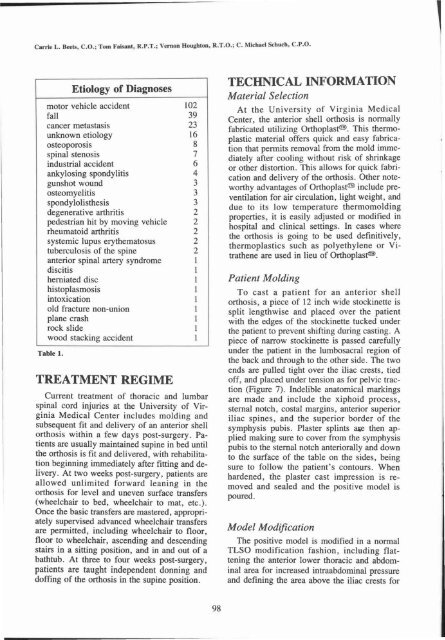View Complete Issue PDF
View Complete Issue PDF
View Complete Issue PDF
Create successful ePaper yourself
Turn your PDF publications into a flip-book with our unique Google optimized e-Paper software.
TECHNICAL INFORMATION<br />
Material<br />
Selection<br />
At the University of Virginia Medical<br />
Center, the anterior shell orthosis is normally<br />
fabricated utilizing Orthoplast®. This thermoplastic<br />
material offers quick and easy fabrication<br />
that permits removal from the mold immediately<br />
after cooling without risk of shrinkage<br />
or other distortion. This allows for quick fabrication<br />
and delivery of the orthosis. Other noteworthy<br />
advantages of Orthoplast® include preventilation<br />
for air circulation, light weight, and<br />
due to its low temperature thermomolding<br />
properties, it is easily adjusted or modified in<br />
hospital and clinical settings. In cases where<br />
the orthosis is going to be used definitively,<br />
thermoplastics such as polyethylene or Vitrathene<br />
are used in lieu of Orthoplast®.<br />
Table 1.<br />
TREATMENT REGIME<br />
Current treatment of thoracic and lumbar<br />
spinal cord injuries at the University of Virginia<br />
Medical Center includes molding and<br />
subsequent fit and delivery of an anterior shell<br />
orthosis within a few days post-surgery. Patients<br />
are usually maintained supine in bed until<br />
the orthosis is fit and delivered, with rehabilitation<br />
beginning immediately after fitting and delivery.<br />
At two weeks post-surgery, patients are<br />
allowed unlimited forward leaning in the<br />
orthosis for level and uneven surface transfers<br />
(wheelchair to bed, wheelchair to mat, etc.).<br />
Once the basic transfers are mastered, appropriately<br />
supervised advanced wheelchair transfers<br />
are permitted, including wheelchair to floor,<br />
floor to wheelchair, ascending and descending<br />
stairs in a sitting position, and in and out of a<br />
bathtub. At three to four weeks post-surgery,<br />
patients are taught independent donning and<br />
doffing of the orthosis in the supine position.<br />
Patient<br />
Molding<br />
To cast a patient for an anterior shell<br />
orthosis, a piece of 12 inch wide stockinette is<br />
split lengthwise and placed over the patient<br />
with the edges of the stockinette tucked under<br />
the patient to prevent shifting during casting. A<br />
piece of narrow stockinette is passed carefully<br />
under the patient in the lumbosacral region of<br />
the back and through to the other side. The two<br />
ends are pulled tight over the iliac crests, tied<br />
off, and placed under tension as for pelvic traction<br />
(Figure 7). Indelible anatomical markings<br />
are made and include the xiphoid process,<br />
sternal notch, costal margins, anterior superior<br />
iliac spines, and the superior border of the<br />
symphysis pubis. Plaster splints ase then applied<br />
making sure to cover from the symphysis<br />
pubis to the sternal notch anteriorally and down<br />
to the surface of the table on the sides, being<br />
sure to follow the patient's contours. When<br />
hardened, the plaster cast impression is removed<br />
and sealed and the positive model is<br />
poured.<br />
Model<br />
Modification<br />
The positive model is modified in a normal<br />
TLSO modification fashion, including flattening<br />
the anterior lower thoracic and abdominal<br />
area for increased intraabdominal pressure<br />
and defining the area above the iliac crests for

















